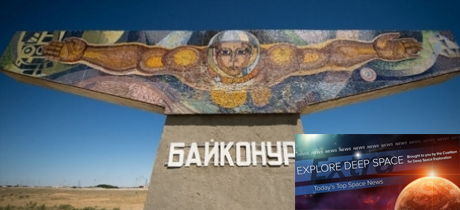In Today’s Deep Space Extra… NASA Administrator Jim Bridenstine, in Russia and Kazakhstan for an International Space Station (ISS) crew launch early Thursday, expressed confidence that a Russian investigation will establish the cause of a small leak detected and repaired aboard the space station in late August. NASA believes a gyro issue with the Hubble Space Telescope can be resolved soon.
Human Space Exploration
NASA head: Space Station hole cause will be determined
Associated Press via Washington Post (10/9): NASA Administrator Jim Bridenstine expressed confidence Tuesday that an investigation into a small air leak in the Russian segment of the International Space Station (ISS) will establish the cause. The leak was detected and repaired August 29-30. The source of the leak was the orbital compartment of the Soyuz MS-09 spacecraft, which is to transport U.S., European and Russian Space Station astronauts back to Earth in December. Bridenstine is to meet with his Russian counterpart Dmitry Rogozin before the scheduled launch early Thursday of the Soyuz MS-10 with two new Space Station crew members, NASA’s Nick Hague and Russia’s Alexey Ovchinin.
Space Science
Hubble Space telescope malfunction won’t last long, NASA says
Space.com (10/9): NASA predicts the gyroscope problem that pressed the Hubble Space Telescope into a safe mode last week will be short lived. Launched in 1990, Hubble was upgraded five times by space shuttle astronauts. The final servicing mission in 2009 included the installation of six new gyroscopes.
Ceres might have tilted over onto its side
Ars Technica (10/9): Ceres, the minor planet/large asteroid with a rugged icy crust and possible source of geophysical activity including volcanism has been the focus of NASA’s Dawn mission since March 2015. Now, a researcher suspects Ceres may have been active enough in its past to tilt over about 36 degrees.
Other News
Price swings expected during shakeout
SpaceNews.com (10/9): Virgin Orbit president Dan Hart predicts changing launch service prices over the next two to three years because of the emergence of new companies and operational approaches. Hart spoke at the Satellite Innovation 2018 conference underway in Mountain View, California. Others noted a decline in the demand for geostationary satellite launches and a rise in the desire for small satellite operations. Rocket reuse could be a price factor as well.
Cosmic cleanup: Russia to help Japan launch galactic garbage collecting mission in 2020
TASS of Russia (10/8): Tokyo-based Astroscale Japan, the first commercial orbital debris clean up company, has contracted with Russia’s Glavkosmos Launch Services for a 2020 demonstration mission. Astroscale’s ELSA-d satellite pair, includes a larger Chaser spacecraft equipped to track, approach and magnetically grab. Target, a smaller spacecraft, will as the name implies stand in for orbital debris.
UP Aerospace targets government customers with $1 million dedicated smallsat launches
SpaceNews.com (10/9): Colorado’s UP Aerospace proposes a solid fueled rocket with a quick response small satellite launch capability. Efforts to develop the Spyder rocket have reached the halfway fund raising point. A 2021 debut is planned and launch costs are estimated at $1 million for a 10 kilogram payload.

